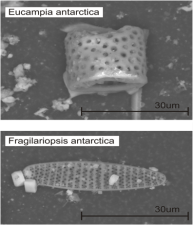West Antarctica wind strength and atmospheric circulation
Reconstructing wind strength and atmospheric circulation in West Antarctica over the past 300 years.
- Start date
- 1 January, 2013
- End date
- 31 December, 2015
Changes in wind strength and circulation patterns above the Antarctic Peninsula are linked to its warming and increased upwelling of warm circumpolar deep water, resulting in accelerated melting and thinning at the base of ice shelves and contributing to the recent collapse of many Antarctic Peninsula ice shelves. In addition, winds above the Southern Ocean drive exchanges of heat and carbon dioxide between the ocean and atmosphere. However, there are few instrumental records of winds prior to the late 20th century in this region, making it difficult to validate models which examine the current and future roles of wind strength and atmospheric circulation on the oceanic circulation in the area and the climate of the Antarctic Peninsula.
The aim of this interdisciplinary project is to combine widely-used ice core chemical tracers of wind strength and long-range circulation (dust content, hydrological, and continental tracers) with an innovative marine biological tracer of wind strength (marine diatoms in ice cores) to:
- Provide the first comprehensive reconstruction of regional wind strength and atmospheric circulation in the Amundsen Sea and Bryan Coast region covering the past 300 years.
- Establish the drivers governing climate variability above the Antarctic peninsula in the recent past.
This project relies on recent shallow ice cores drilled by BAS and which provide unique decadal to centennial scale records of the past climate and environment in the Bryan Coast region. The discovery of marine diatoms (microscopic algae) in those cores, swept out from the sea and onto the ice sheet, provides a new insight into past wind strength from ice cores. The development of a new marine derived ice core proxy at BAS will provide the wider scientific community with a means of reconstructing past wind strength and circulation over centennial to millennial timescales from across the whole Antarctic continent.

- Develop new ice-core tracers for past wind strength and atmospheric circulation above Antarctica
- Determine how past wind strength and circulation influenced climate in the southern peninsula and West Antarctica over that past 300 years
- Use the new palaeoclimatic records to test pre-industrial climate models currently used to predict future climate change in West Antarctica and identify the key climate drivers
Stephen Roberts
Quaternary Geologist
BAS-Arctic Working Group, Palaeo Environments, Ice Sheets and Climate Change team
Collaborators and project partners:
Melanie Lang and Carol Arrowsmith , NERC Isotope Geosciences Laboratory NIGL
Alexander Tudhope, University of Edinburgh (NE/H009957/1: Quantifying variability in the El Niño Southern Oscillation on adaptation-relevant timescales)